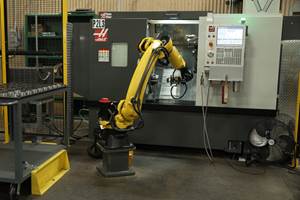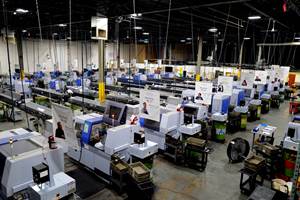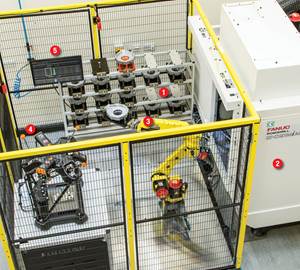MMS Looks Back: 1970s - When We Looked Back and Forward
One article in the 50th anniversary issue recapped the emerging technologies covered in years past, but another predicted how the digital computer and automation might impact our industry in the future. This story is part of our 90th anniversary series.
Share






The June 1978 edition of 91ÊÓƵÍøÕ¾ÎÛ was significant in that it was the 50th anniversary issue. Its cover imagery as shown above portrayed both a bit of nostalgia (belt-driven machine tools) and a bit of foreshadowing (the advent of computer technology applied in manufacturing).
For that issue, the editors created a yearly-diary-like article citing world events, changes that had been made to the magazine, and topics, trends and technologies that were covered in each of the magazine’s 50 years. The section about the 1970s offers evidence that digital computer technology would start to be implemented in manufacturing operations in significant ways. For example, the 1974 blurb says it “looks like the CAD/CAM concept is becoming a ‘buzzword’ as an outgrowth of numerical control (NC). I can see the real beginning of high interest in the use of the computer for the entire plant manufacturing environment.” The 1976 blurb points to the “dominance of computer numerical control (CNC) at the International Machine Tool Show,” known today as the .
Therefore, it is not surprising that in the era when the impact of new CNC machine tool technology was just starting to be felt, the subsequent article in that issue titled “Computers Advancing World Manufacturing Technology” features an industry expert’s predictions about how computer technology would change the face of machining and manufacturing in the years to come. Dr. M. Eugene Merchant, the director of research planning for Cincinnati Milacron at the time said:
- By 1980, a computer software system for full automation and optimization of all steps in the manufacturing of a workpiece would be developed and in wide use.
- By 1985, full online automation and optimization of complete manufacturing plants controlled by a central computer would be a reality.
- By 1990, more than 50 percent of the machine tools produced would no longer “stand alone.” Instead, multiple machines would be grouped in cells (he did not use that word) with material-handling systems that would be controlled by a central computer.
- By 2000, the “computer-integrated automatic factory” would be a full-blown reality.
There would be two major productivity-enhancing incentives for establishing such an automated, computerized shop, Dr. Merchant said. The first would be to “reduce the time workpieces spend in process in the shop. This would reduce the high and costly inventory of unfinished parts on the shop floor and of finished parts waiting for others in process so that assembly of the product could proceed.” The second would be “vastly improved machine tool utilization.”
To this day, these remain important manufacturing goals for shops, and shopfloor practices based on the power of today’s computers and software (as well as tablet devices and apps) continue to be devised and applied to achieve them. However, when he talked about automation, was he thinking primarily in terms of robotics and “hands-free” flow of parts from machine to machine through a facility? An artist’s rendering of an automated machining cell in the article suggests this. Clearly, there are some advanced manufacturing facilities that do function as such with minimal human intervention. However, there are still many shops today in which there is no robot to be seen. Plus, it is ironic in that new collaborative robots featuring designs that enable a human to work safely alongside them are becoming increasingly popular.
That said, there are other elements of automation that shops can leverage to reduce overall production time and improve machine utilization. For example, on-machine probing technology can automatically measure cutting tools and determine if a tool has broken as well as probe workpieces to speed setups or measure machined features to detect if the process is trending out of specification. Presetters can similarly automatically measure tools outside the machine. Bar feeders and parts collectors on turning centers enable long stretches of unattended machining. Five-axis and turn-mill machining are forms of automation in that they can machine multiple part features (sometimes all part features) in one setup, eliminating the need for operators to set up those parts on multiple machines. Sensors mounted on some of today’s machine tools feed information to enable a CNC to automatically change parameters depending if the data suggests there is a problem.
Ultimately, though, it seems Dr. Merchant was predicting how computer technology would serve to connect disparate elements of manufacturing as that rendering in the article also suggests. Given the level of connectivity that has been established not only in manufacturing, but myriad aspects of our personal lives, I would say he was spot-on in that regard.
Related Content
Increasing Productivity with Digitalization and AI
Job shops are implementing automation and digitalization into workflows to eliminate set up time and increase repeatability in production.
Read MoreWhich Approach to Automation Fits Your CNC Machine Tool?
Choosing the right automation to pair with a CNC machine tool cell means weighing various factors, as this fabrication business has learned well.
Read MoreInside the Premium Machine Shop Making Fasteners
AMPG can’t help but take risks — its management doesn’t know how to run machines. But these risks have enabled it to become a runaway success in its market.
Read More5 Stages of a Closed-Loop CNC Machining Cell
Controlling variability in a closed-loop manufacturing process requires inspection data collected before, during and immediately after machining — and a means to act on that data in real time. Here’s one system that accomplishes this.
Read MoreRead Next
Machine Shop MBA
Making Chips and 91ÊÓƵÍøÕ¾ÎÛ are teaming up for a new podcast series called Machine Shop MBA—designed to help manufacturers measure their success against the industry’s best. Through the lens of the Top Shops benchmarking program, the series explores the KPIs that set high-performing shops apart, from machine utilization and first-pass yield to employee engagement and revenue per employee.
Read MoreLast Chance! 2025 Top Shops Benchmarking Survey Still Open Through April 30
Don’t miss out! 91ÊÓƵÍøÕ¾ÎÛ's Top Shops Benchmarking Survey is still open — but not for long. This is your last chance to a receive free, customized benchmarking report that includes actionable feedback across several shopfloor and business metrics.
Read MoreAMRs Are Moving Into Manufacturing: 4 Considerations for Implementation
AMRs can provide a flexible, easy-to-use automation platform so long as manufacturers choose a suitable task and prepare their facilities.
Read More





















